Stratosphere Jumping
In the boundless darkness of the black sky stars shine, they seem very close and somehow not real. I’m looking at an altimeter - already nineteen thousand meters. At this height, the fall occurs at the highest rate. When he reached a height of twelve thousand meters, the speed decreased, the tension devices of the high-altitude suit weakened. I sigh freely, straighten my body and turn over face down. Falling becomes very easy. Below the Volga with its numerous tributaries. Although a marine life jacket is worn over high-altitude equipment, I don’t feel like swimming ...
From the memoirs of E. N. Andreev about the assault on the stratosphere, November 1, 1962
Cosmonautics Day will come the day after tomorrow, and then a probe with our server and several satellite modems on board will fly into the stratosphere. In the next article, we will talk about the technical implementation of our “ Space Data Center ”, and today we offer to recall some of the accomplishments of the past years - parachute jumps from the stratosphere.
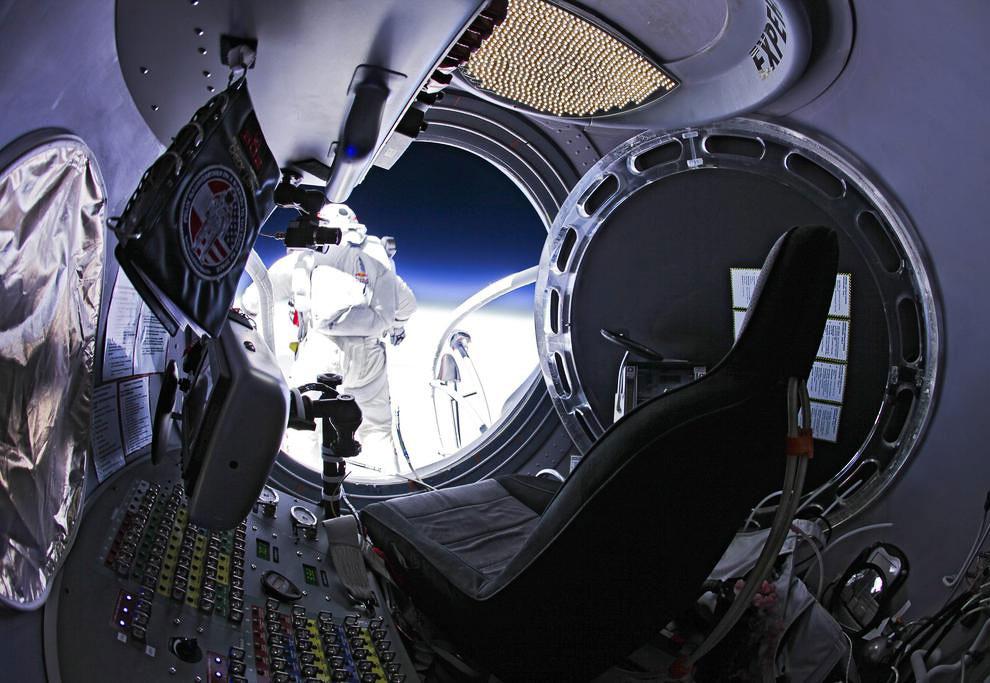
For centuries, people have dreamed of flying like birds. Now flying in the atmosphere no longer surprise anyone, we are used to it. Flying has become routine and popular entertainment. And it all started with “aircraft lighter than air” - balloons. At the beginning of our era, the history of the “Chinese lanterns” began: light paper shells rising into the sky thanks to the warm air from the candle tied to them. Like many other inventions, this idea was used for military purposes - to send signals to the troops.
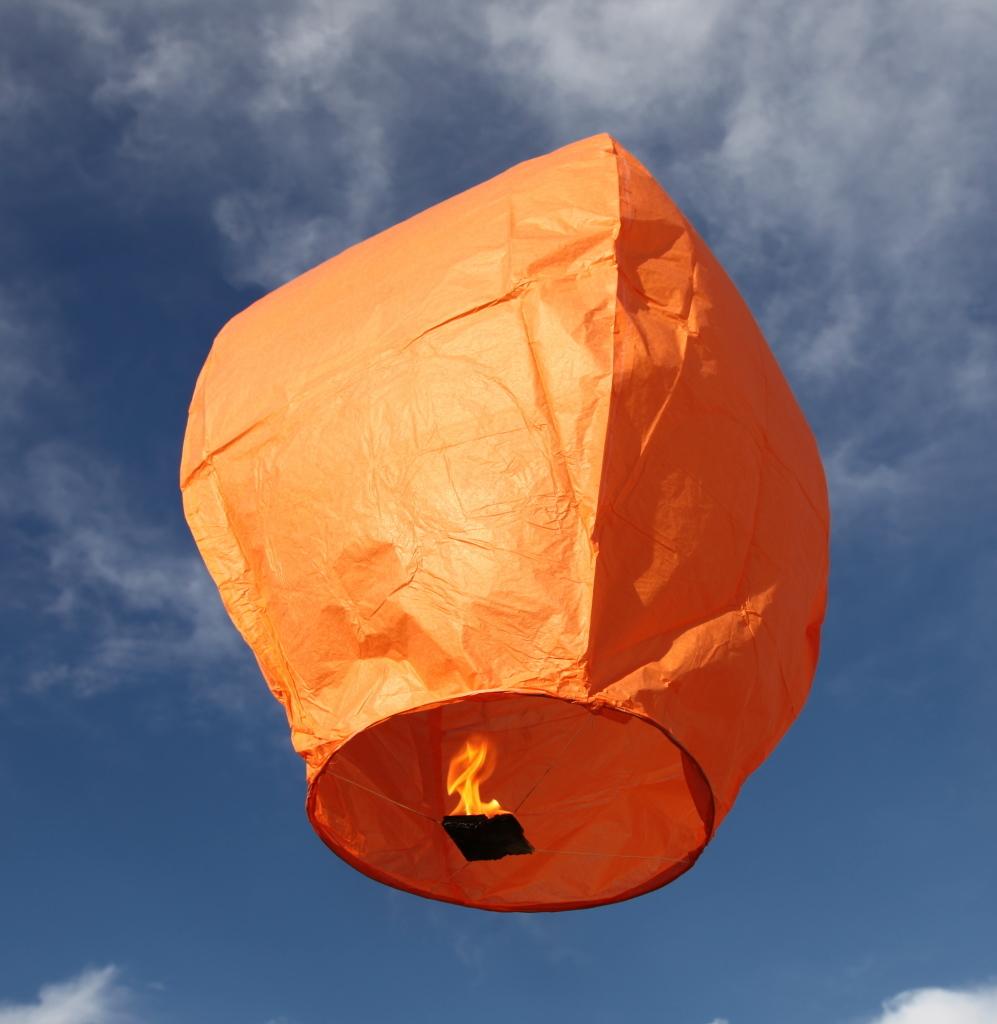
And only after many centuries a man took to the air. The famous Montgolfier brothers designed a balloon on which people first flew into the air.
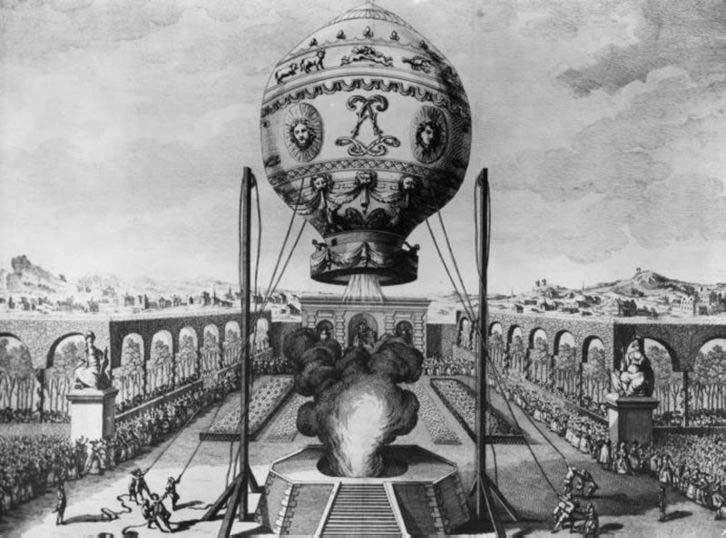
More than a century has passed, "aviation is lighter than air" has developed into a whole transport industry, and then was replaced by "vehicles heavier than air." But technical thought developed, and the desire to step beyond and rise even higher led to the development of stratonautics - flying on stratospheric balloons to such heights that not all planes can climb. In the history of stratonautics there are tragedies and triumphs no worse than in aviation and astronautics, there are milestones.
In the Age of Enlightenment, it was believed that above 12 kilometers the atmosphere ends and airless space begins. Modern science distinguishes many layers in the structure of the atmosphere that differ in physical properties and composition. The stratosphere is the range of heights from 11 to 50 km. Devices “lighter than air” rising into this layer are called stratostats.
The first "Stratosphere Balloons" were scientists Auguste Piccard and Paul Kipfer. In 1930, Piccard designed the first ever stratospheric balloon called FNRS-1, which is the abbreviation of the National Foundation for Scientific Research (Fonds National de la Recherche Scientifique). Together with Kipfer Picard in 1931 climbed to a height of 15.7 km.
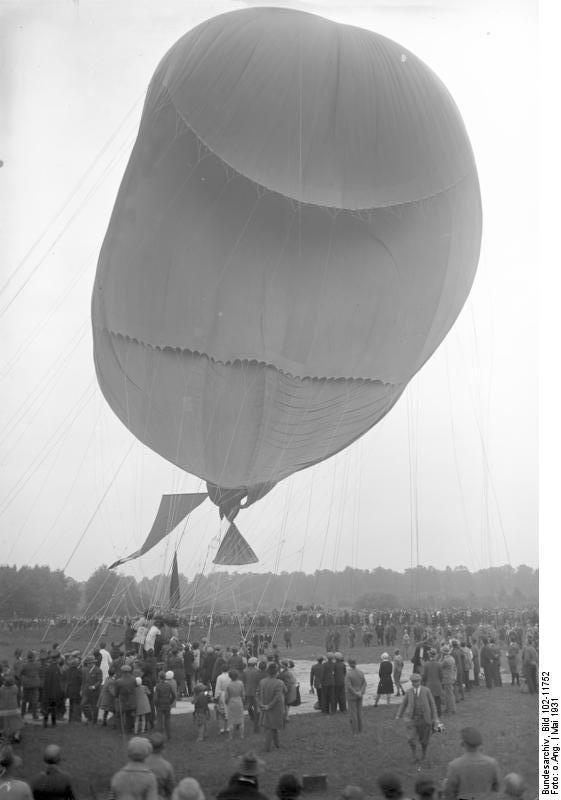
During his long and eventful life, the Belgian made 27 flights on stratospheres, invented the bathyscaphe and plunged into the Mariana Trench to a depth of almost 11 km.
After FNRS-1, flights to an unprecedented height were also interested in the USSR. The tense international situation made us think about high-altitude military aircraft, inaccessible to fighters of that time and anti-aircraft guns. In addition, we wanted to explore the recently discovered cosmic rays - the naturally ionizing radiation that comes to Earth from space. The data obtained with the help of unmanned stratospheric balloons was not enough, and on September 30, 1933 the first Soviet manned stratospheric balloon - “USSR-1” took off. He climbed to a record height of 19 km.
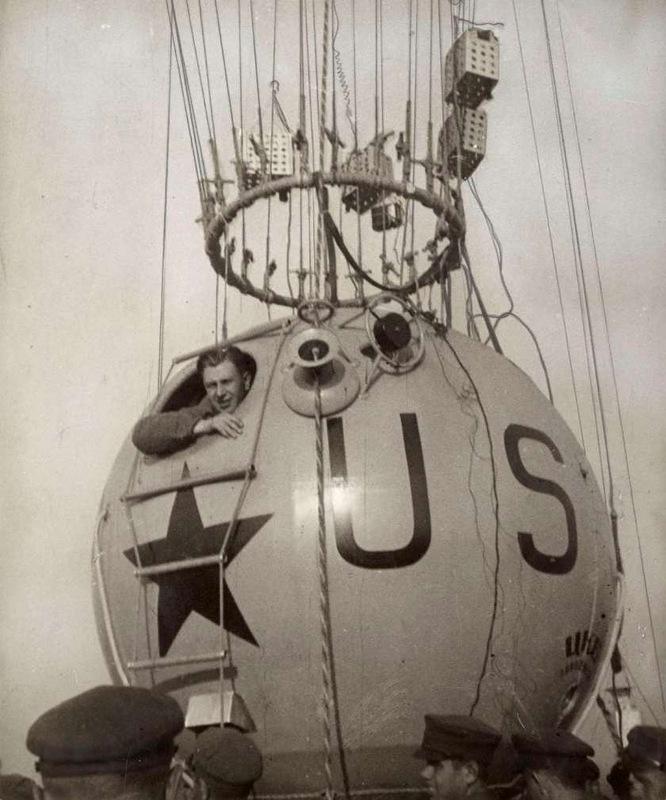
Soldiers perform the role of ballast:
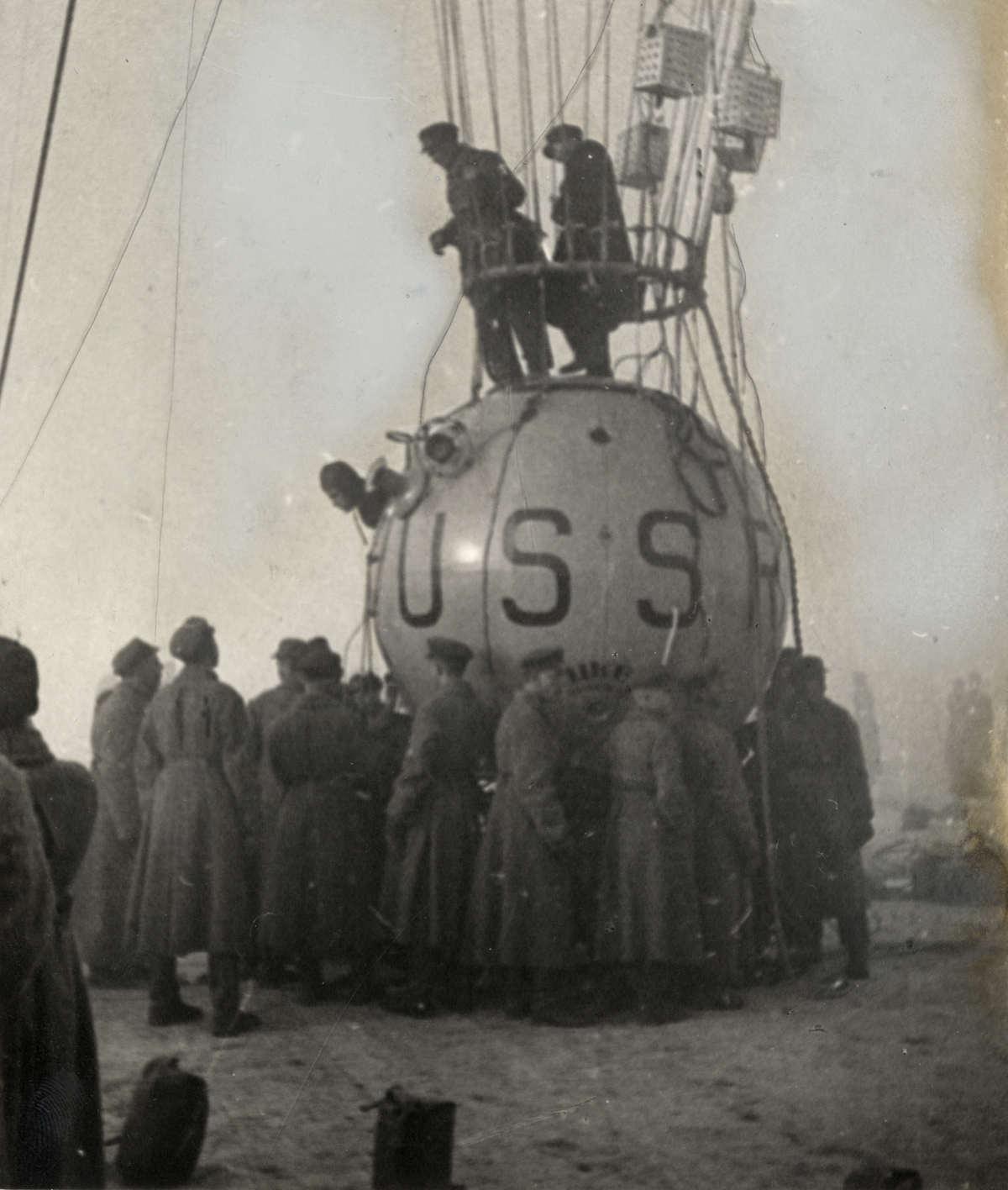
The heroes who piloted him were three pilots: Ernst Birnbaum, Konstantin Godunov and George Prokofiev. Godunov worked as the head of the design bureau, which created the shell of the stratospheric balloon, while Birnbaum and Prokofiev served in the Red Army and were experienced pilots of balloons. Ernst continued to fly even later, and during the Great Patriotic War, he commanded the Moscow barrage balloons. The fate of George was tragic, he committed suicide at the age of 36 years.
The next Soviet experiment - the stratospheric balloon “Osoaviahim-1” - bore the name of the socio-political organization “Society for the Assistance to Defense, Aircraft and Chemical Construction,” several engineers of which developed the apparatus.
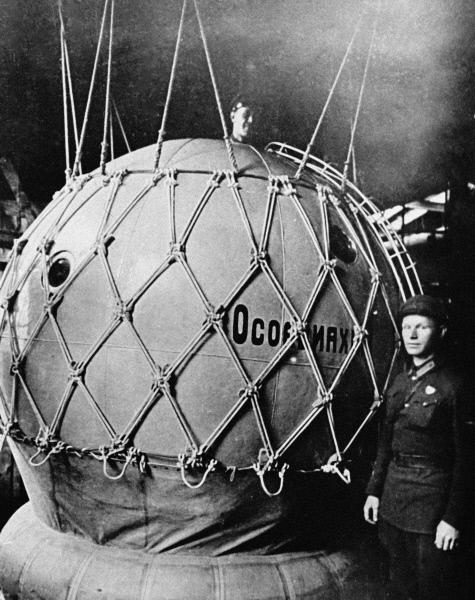
Traditionally, one of the pilots of the stratospheric balloon was its chief designer, engineer Andrei Vasenko. The team had an ambitious science program led by academician Abram Ioffe. In flight, they planned to study cosmic rays, study the composition of the atmosphere and the Earth's magnetic field. In addition, they decided to carry out a biological experiment on board and manned the “crew" of Drosophila flies. The co-pilot, physicist Ilya Usyskin, a graduate of the Leningrad Polytechnic, was responsible for scientific experiments on board. The crew commander was a military pilot Pavel Fedoseenko, who had many years of experience flying on balloons, commanded an aeronautical detachment in the Civil War and graduated from the airship building department of the Air Force Academy. Osoaviahim-1 set a world record, reaching an altitude of 22 km above sea level, but the flight ended in tragedy:
Another relatively successful experiment was the USSR-1 bis stratospheric balloon.

The crew commander was Kristap Zille, an experienced military pilot-balloonist, chief of staff of the 4th Air Division. The co-pilot was a military engineer Yuri Prilutsky, and Alexander Verigo, professor of the State Geophysical Observatory, was supposed to be engaged in scientific work. It was not for nothing that they called the stratostat “USSR-1 bis”: the shell of the balloon and gondola were like that of the first Soviet stratostat, but it was also equipped with a rescue parachute. The scientific program promised to be saturated, among the equipment were astronomical instruments: a spectrograph and a device for studying the brightness of the sky; aerial photography equipment; Hessian electrometers, two Wilson cameras, thermometers, a barometer and two altimeters. Outside the nacelles hung vessels for taking air samples and many other instruments. Although a tragedy like Osoaviahim 1 was avoided, mission cannot be called completely successful. Having risen to a height of 16 kilometers, the crew completed a scientific program and began to decrease, but the speed was too high, there was a hydrogen leak, ballast discharge did not improve the situation. Pilots decided not to use a gondola parachute, because landing with it would have turned out to be too rigid and scientific equipment could not stand it. Instead, they decided to lighten the gondola by jumping out of it with parachutes themselves. At an altitude of 3.5 kilometers Verigo jumped out, then, at an altitude of 2 kilometers - Prilutsky. Zille was left alone; dropping all the remaining ballast, he brought the rate of decline to acceptable. Nevertheless, having decided to play it safe, before boarding he got out of the gondola, catching on the stairs on its outer side. But the precaution turned out to be unnecessary, the stratospheric balloon made a soft landing,
All subsequent Soviet experiments ended unsuccessfully and even tragically.
In the summer of 1934, the USSR-2 burned out at the start, fortunately no one was hurt.
The USSR-3 stratospheric balloon also failed to fulfill its mission. His crew included: Colonel Prokofiev, brigadier engineer Semenov and military engineer of the 2nd rank Prilutsky. Prokofiev was originally the commander of the Experimental Testing Aeronautical Division, but was removed from his post after an accident at the training ground. The launch was postponed many times, as a result, the stratospheric balloon took off in the fall of 1937, but the balloon broke at an altitude of less than a kilometer. The gondola fell, the crew was seriously injured, after which the pilots were recovering in the hospital for several months.
In the summer of 1938, because of the failure of the life support system, the crew of the VVA-1 stratospheric observatory, named after the Zhukovsky Air Force Academy, died. When landing, with an already dead crew, the stratospheric balloon fell onto a high-voltage power line and caught fire.
In the summer of 1940, immediately after the start, “Osoaviahim-2” collapsed. The height was very small and the pilots escaped with bruises.
After such a series of failures, the idea of stratonautics was finally discredited in the eyes of the USSR leadership and the experiments were permanently stopped. A new period of construction of Soviet stratostats began many years later, with the beginning of the space age, to develop new technologies. The Volga stratospheric balloon was launched in 1962 to test the landing of the spacecraft descent vehicle, the jump from it and the bailout.

The crew consisted of two test paratroopers. The stratospheric balloon rose to a height of 28.6 kilometers, Yevgeny Andreev ejected and successfully landed, and Peter Dolgov jumped with a parachute, but died due to depressurization of the spacesuit.
Overseas, too, did not remain aloof from the conquest of the stratosphere.
In the years 1933-1934, Jean Picard, the twin brother of Auguste Picard, who lived in the United States, built the Century of Progress stratospheric balloon. In the first flight, he climbed to a height of 17.5 kilometers. Curiously, the sponsor of the flight was Henry Ford himself. In the second flight, Jean took his wife, Jeannette Ridlon, who became the first female stratonaut. In the summer of 1934, scientists Orville Anderson, Albert Stevens and William Kepner took off on the Explorer I stratosphere balloon. At an altitude of 18 kilometers, the shell broke and the crew jumped with parachutes, everyone landed safely.
The following year, the same Anderson and Stevens took off on the Explorer II stratospheric balloon. The flight was successful, they set a height record of 22,066 meters, which lasted more than 20 years.
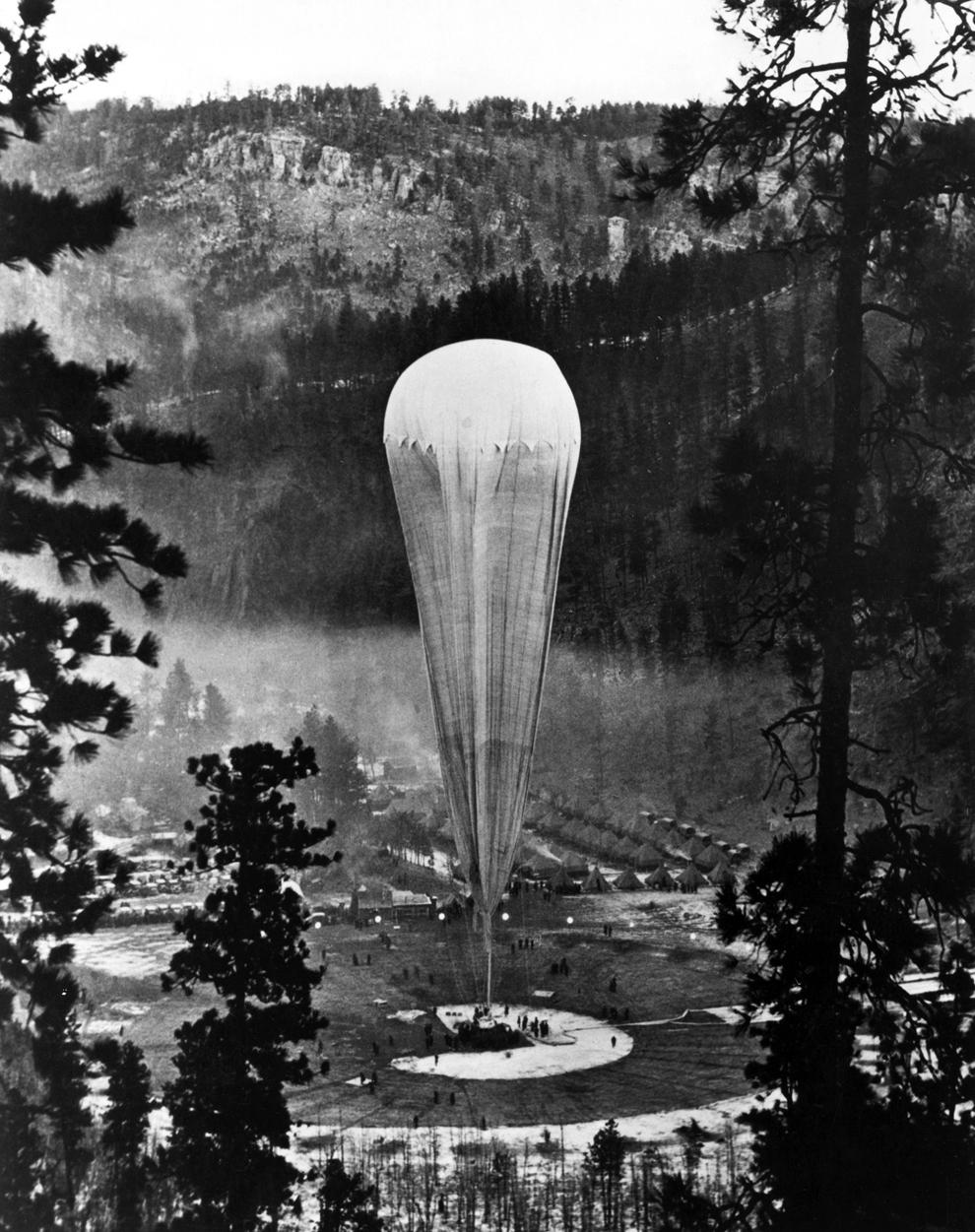
Then the Americans took a long pause, and the next flights were already tests of space technology, as in the USSR, and they were conducted not by enthusiasts with private sponsors, but by the US Air Force. From 1955 to 1958, the Man High project was in operation, within the framework of which they checked the life support systems in the stratosphere, studied the crew’s well-being in conditions close to space, found out the influence of cosmic rays on a person and tested landing systems with ejection. During the tests, three stratostats were launched: Man High I, Man High II and Man High III. Joseph Kittinger became the first pilot, and he immediately set a height record of almost 30 kilometers. The second stratospheric balloon with pilot David Simons rose even higher: 30,942 meters. The third stratospheric balloon was piloted by Clifton McClure. So many developments of this program,
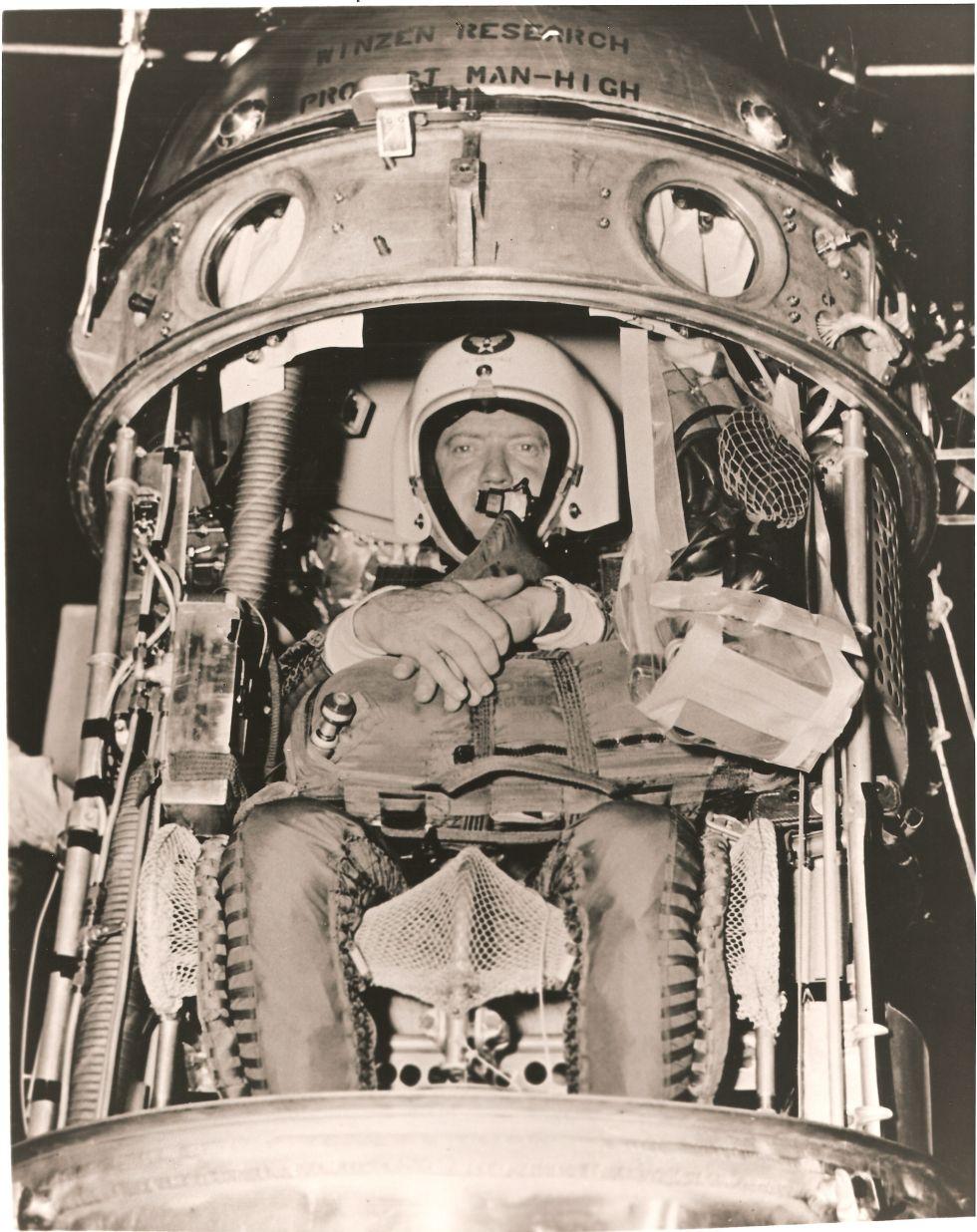

In addition to traditional stratostats with pressurized gondolas, in the late 1950s, Americans carried out extremely risky flights in open cockpits, testing the suits of aircraft pilots and astronauts, and also practiced high-altitude parachute jumps. The tests were carried out as part of Excelsior projects in which the aforementioned Joseph Kittinger participated.
Kittinger completed three jumps, almost dying in the first of them. In the fall of 1959, rising to a height of 23,300 meters, he jumped out of the gondola, but a malfunction of the stabilizing parachute introduced him into a wild corkscrew with a rotation speed of 2 revolutions per second and overloads of up to 22g. The pilot lost consciousness and was saved only thanks to the automatic system that opened the emergency parachute. The second jump was from a height of 22,760 meters. During the third jump of 1960, there was a slight depressurization of the spacesuit and Kittinger injured his hand, but set a whole set of records: height - 31,300 meters; a fall speed of 988 km / h and a fall time of 4 minutes 36 seconds.

In parallel with the purely military trials, Man High and Excelsior underwent scientific flights under the Strato Lab program. The main tasks were astronomical observations and cosmic ray research. From 1956 to 1961, 9 flights were performed at altitudes from 12,000 meters to 34,668 meters, which were then record-breaking. In one of the flights, pilot Alfred Meiksel first conducted astronomical observation through a telescope mounted in the gondola of the ONR STRATOLAB stratosphere balloon at an altitude of 12 kilometers. The next telescope, which flew in the gondola of the STRATOLAB HIGH IV apparatus to study Mars, rose to a height of 24,689 meters.

This high-altitude observation record through a telescope was broken only by the orbital Hubble.
One of the scientific flights under the Stargazer program was carried out by the same Joseph Kittinger. In the winter of 1962, he and astronomer William White climbed to a height of 19 kilometers and made astronomical observations for more than 15 hours.
Half a century has passed and unique research has turned into entertainment and advertising. In 2010, Red Bull sponsored an ambitious stratospheric long jump project as an advertising campaign for its brand.
For the project, they chose the famous extreme sportsman Felix Baumgartner, an Austrian sky-skater and a baseball player who had been working with the company for many years.
After two training jumps (from altitudes of 21,818 and 29,610 meters), October 14, 2012 Baumgartner climbed to a height that became the next record of manned flights on a stratosphere balloon - 39 kilometers. In addition, he set several more records during the jump: the speed of free fall above the speed of sound is 1357.6 kilometers per hour, and the longest distance that a person has flown in free flight is 36,402.6 meters. The jump video was broadcast live and was watched by 8 million viewers.
The second entertaining jump was not long in coming. Alan Eustace, vice president of Google, jumped from an even greater height of 41,419 meters on October 24, 2014. Unlike all previous flights, the designers decided to do without a gondola and attach the spacesuit directly to the cylinder, and shoot it with a squib at maximum height. This gave great savings in weight and allowed to rise higher.
Judging by the fact that no other jumps are planned yet, the thoughts of wealthy exotic lovers are preoccupied with even more unusual entertainments - suborbital flights, which several companies plan to offer soon.

On April 12, we invite you to take part in our experiment and send a congratulatory message to the server in the stratosphere.

From the memoirs of E. N. Andreev about the assault on the stratosphere, November 1, 1962
Cosmonautics Day will come the day after tomorrow, and then a probe with our server and several satellite modems on board will fly into the stratosphere. In the next article, we will talk about the technical implementation of our “ Space Data Center ”, and today we offer to recall some of the accomplishments of the past years - parachute jumps from the stratosphere.

For centuries, people have dreamed of flying like birds. Now flying in the atmosphere no longer surprise anyone, we are used to it. Flying has become routine and popular entertainment. And it all started with “aircraft lighter than air” - balloons. At the beginning of our era, the history of the “Chinese lanterns” began: light paper shells rising into the sky thanks to the warm air from the candle tied to them. Like many other inventions, this idea was used for military purposes - to send signals to the troops.

And only after many centuries a man took to the air. The famous Montgolfier brothers designed a balloon on which people first flew into the air.

More than a century has passed, "aviation is lighter than air" has developed into a whole transport industry, and then was replaced by "vehicles heavier than air." But technical thought developed, and the desire to step beyond and rise even higher led to the development of stratonautics - flying on stratospheric balloons to such heights that not all planes can climb. In the history of stratonautics there are tragedies and triumphs no worse than in aviation and astronautics, there are milestones.
In the Age of Enlightenment, it was believed that above 12 kilometers the atmosphere ends and airless space begins. Modern science distinguishes many layers in the structure of the atmosphere that differ in physical properties and composition. The stratosphere is the range of heights from 11 to 50 km. Devices “lighter than air” rising into this layer are called stratostats.
The first "Stratosphere Balloons" were scientists Auguste Piccard and Paul Kipfer. In 1930, Piccard designed the first ever stratospheric balloon called FNRS-1, which is the abbreviation of the National Foundation for Scientific Research (Fonds National de la Recherche Scientifique). Together with Kipfer Picard in 1931 climbed to a height of 15.7 km.

During his long and eventful life, the Belgian made 27 flights on stratospheres, invented the bathyscaphe and plunged into the Mariana Trench to a depth of almost 11 km.
After FNRS-1, flights to an unprecedented height were also interested in the USSR. The tense international situation made us think about high-altitude military aircraft, inaccessible to fighters of that time and anti-aircraft guns. In addition, we wanted to explore the recently discovered cosmic rays - the naturally ionizing radiation that comes to Earth from space. The data obtained with the help of unmanned stratospheric balloons was not enough, and on September 30, 1933 the first Soviet manned stratospheric balloon - “USSR-1” took off. He climbed to a record height of 19 km.

Soldiers perform the role of ballast:

The heroes who piloted him were three pilots: Ernst Birnbaum, Konstantin Godunov and George Prokofiev. Godunov worked as the head of the design bureau, which created the shell of the stratospheric balloon, while Birnbaum and Prokofiev served in the Red Army and were experienced pilots of balloons. Ernst continued to fly even later, and during the Great Patriotic War, he commanded the Moscow barrage balloons. The fate of George was tragic, he committed suicide at the age of 36 years.
The next Soviet experiment - the stratospheric balloon “Osoaviahim-1” - bore the name of the socio-political organization “Society for the Assistance to Defense, Aircraft and Chemical Construction,” several engineers of which developed the apparatus.

Traditionally, one of the pilots of the stratospheric balloon was its chief designer, engineer Andrei Vasenko. The team had an ambitious science program led by academician Abram Ioffe. In flight, they planned to study cosmic rays, study the composition of the atmosphere and the Earth's magnetic field. In addition, they decided to carry out a biological experiment on board and manned the “crew" of Drosophila flies. The co-pilot, physicist Ilya Usyskin, a graduate of the Leningrad Polytechnic, was responsible for scientific experiments on board. The crew commander was a military pilot Pavel Fedoseenko, who had many years of experience flying on balloons, commanded an aeronautical detachment in the Civil War and graduated from the airship building department of the Air Force Academy. Osoaviahim-1 set a world record, reaching an altitude of 22 km above sea level, but the flight ended in tragedy:
Another relatively successful experiment was the USSR-1 bis stratospheric balloon.

The crew commander was Kristap Zille, an experienced military pilot-balloonist, chief of staff of the 4th Air Division. The co-pilot was a military engineer Yuri Prilutsky, and Alexander Verigo, professor of the State Geophysical Observatory, was supposed to be engaged in scientific work. It was not for nothing that they called the stratostat “USSR-1 bis”: the shell of the balloon and gondola were like that of the first Soviet stratostat, but it was also equipped with a rescue parachute. The scientific program promised to be saturated, among the equipment were astronomical instruments: a spectrograph and a device for studying the brightness of the sky; aerial photography equipment; Hessian electrometers, two Wilson cameras, thermometers, a barometer and two altimeters. Outside the nacelles hung vessels for taking air samples and many other instruments. Although a tragedy like Osoaviahim 1 was avoided, mission cannot be called completely successful. Having risen to a height of 16 kilometers, the crew completed a scientific program and began to decrease, but the speed was too high, there was a hydrogen leak, ballast discharge did not improve the situation. Pilots decided not to use a gondola parachute, because landing with it would have turned out to be too rigid and scientific equipment could not stand it. Instead, they decided to lighten the gondola by jumping out of it with parachutes themselves. At an altitude of 3.5 kilometers Verigo jumped out, then, at an altitude of 2 kilometers - Prilutsky. Zille was left alone; dropping all the remaining ballast, he brought the rate of decline to acceptable. Nevertheless, having decided to play it safe, before boarding he got out of the gondola, catching on the stairs on its outer side. But the precaution turned out to be unnecessary, the stratospheric balloon made a soft landing,
All subsequent Soviet experiments ended unsuccessfully and even tragically.
In the summer of 1934, the USSR-2 burned out at the start, fortunately no one was hurt.
The USSR-3 stratospheric balloon also failed to fulfill its mission. His crew included: Colonel Prokofiev, brigadier engineer Semenov and military engineer of the 2nd rank Prilutsky. Prokofiev was originally the commander of the Experimental Testing Aeronautical Division, but was removed from his post after an accident at the training ground. The launch was postponed many times, as a result, the stratospheric balloon took off in the fall of 1937, but the balloon broke at an altitude of less than a kilometer. The gondola fell, the crew was seriously injured, after which the pilots were recovering in the hospital for several months.
In the summer of 1938, because of the failure of the life support system, the crew of the VVA-1 stratospheric observatory, named after the Zhukovsky Air Force Academy, died. When landing, with an already dead crew, the stratospheric balloon fell onto a high-voltage power line and caught fire.
In the summer of 1940, immediately after the start, “Osoaviahim-2” collapsed. The height was very small and the pilots escaped with bruises.
After such a series of failures, the idea of stratonautics was finally discredited in the eyes of the USSR leadership and the experiments were permanently stopped. A new period of construction of Soviet stratostats began many years later, with the beginning of the space age, to develop new technologies. The Volga stratospheric balloon was launched in 1962 to test the landing of the spacecraft descent vehicle, the jump from it and the bailout.

The crew consisted of two test paratroopers. The stratospheric balloon rose to a height of 28.6 kilometers, Yevgeny Andreev ejected and successfully landed, and Peter Dolgov jumped with a parachute, but died due to depressurization of the spacesuit.
Overseas, too, did not remain aloof from the conquest of the stratosphere.
In the years 1933-1934, Jean Picard, the twin brother of Auguste Picard, who lived in the United States, built the Century of Progress stratospheric balloon. In the first flight, he climbed to a height of 17.5 kilometers. Curiously, the sponsor of the flight was Henry Ford himself. In the second flight, Jean took his wife, Jeannette Ridlon, who became the first female stratonaut. In the summer of 1934, scientists Orville Anderson, Albert Stevens and William Kepner took off on the Explorer I stratosphere balloon. At an altitude of 18 kilometers, the shell broke and the crew jumped with parachutes, everyone landed safely.
The following year, the same Anderson and Stevens took off on the Explorer II stratospheric balloon. The flight was successful, they set a height record of 22,066 meters, which lasted more than 20 years.

Then the Americans took a long pause, and the next flights were already tests of space technology, as in the USSR, and they were conducted not by enthusiasts with private sponsors, but by the US Air Force. From 1955 to 1958, the Man High project was in operation, within the framework of which they checked the life support systems in the stratosphere, studied the crew’s well-being in conditions close to space, found out the influence of cosmic rays on a person and tested landing systems with ejection. During the tests, three stratostats were launched: Man High I, Man High II and Man High III. Joseph Kittinger became the first pilot, and he immediately set a height record of almost 30 kilometers. The second stratospheric balloon with pilot David Simons rose even higher: 30,942 meters. The third stratospheric balloon was piloted by Clifton McClure. So many developments of this program,


In addition to traditional stratostats with pressurized gondolas, in the late 1950s, Americans carried out extremely risky flights in open cockpits, testing the suits of aircraft pilots and astronauts, and also practiced high-altitude parachute jumps. The tests were carried out as part of Excelsior projects in which the aforementioned Joseph Kittinger participated.
Kittinger completed three jumps, almost dying in the first of them. In the fall of 1959, rising to a height of 23,300 meters, he jumped out of the gondola, but a malfunction of the stabilizing parachute introduced him into a wild corkscrew with a rotation speed of 2 revolutions per second and overloads of up to 22g. The pilot lost consciousness and was saved only thanks to the automatic system that opened the emergency parachute. The second jump was from a height of 22,760 meters. During the third jump of 1960, there was a slight depressurization of the spacesuit and Kittinger injured his hand, but set a whole set of records: height - 31,300 meters; a fall speed of 988 km / h and a fall time of 4 minutes 36 seconds.

In parallel with the purely military trials, Man High and Excelsior underwent scientific flights under the Strato Lab program. The main tasks were astronomical observations and cosmic ray research. From 1956 to 1961, 9 flights were performed at altitudes from 12,000 meters to 34,668 meters, which were then record-breaking. In one of the flights, pilot Alfred Meiksel first conducted astronomical observation through a telescope mounted in the gondola of the ONR STRATOLAB stratosphere balloon at an altitude of 12 kilometers. The next telescope, which flew in the gondola of the STRATOLAB HIGH IV apparatus to study Mars, rose to a height of 24,689 meters.

This high-altitude observation record through a telescope was broken only by the orbital Hubble.
One of the scientific flights under the Stargazer program was carried out by the same Joseph Kittinger. In the winter of 1962, he and astronomer William White climbed to a height of 19 kilometers and made astronomical observations for more than 15 hours.
Half a century has passed and unique research has turned into entertainment and advertising. In 2010, Red Bull sponsored an ambitious stratospheric long jump project as an advertising campaign for its brand.
For the project, they chose the famous extreme sportsman Felix Baumgartner, an Austrian sky-skater and a baseball player who had been working with the company for many years.
After two training jumps (from altitudes of 21,818 and 29,610 meters), October 14, 2012 Baumgartner climbed to a height that became the next record of manned flights on a stratosphere balloon - 39 kilometers. In addition, he set several more records during the jump: the speed of free fall above the speed of sound is 1357.6 kilometers per hour, and the longest distance that a person has flown in free flight is 36,402.6 meters. The jump video was broadcast live and was watched by 8 million viewers.
The second entertaining jump was not long in coming. Alan Eustace, vice president of Google, jumped from an even greater height of 41,419 meters on October 24, 2014. Unlike all previous flights, the designers decided to do without a gondola and attach the spacesuit directly to the cylinder, and shoot it with a squib at maximum height. This gave great savings in weight and allowed to rise higher.
Judging by the fact that no other jumps are planned yet, the thoughts of wealthy exotic lovers are preoccupied with even more unusual entertainments - suborbital flights, which several companies plan to offer soon.

On April 12, we invite you to take part in our experiment and send a congratulatory message to the server in the stratosphere.

